engine overheat GENESIS G90 2017 User Guide
[x] Cancel search | Manufacturer: GENESIS, Model Year: 2017, Model line: G90, Model: GENESIS G90 2017Pages: 524, PDF Size: 19.3 MB
Page 365 of 524
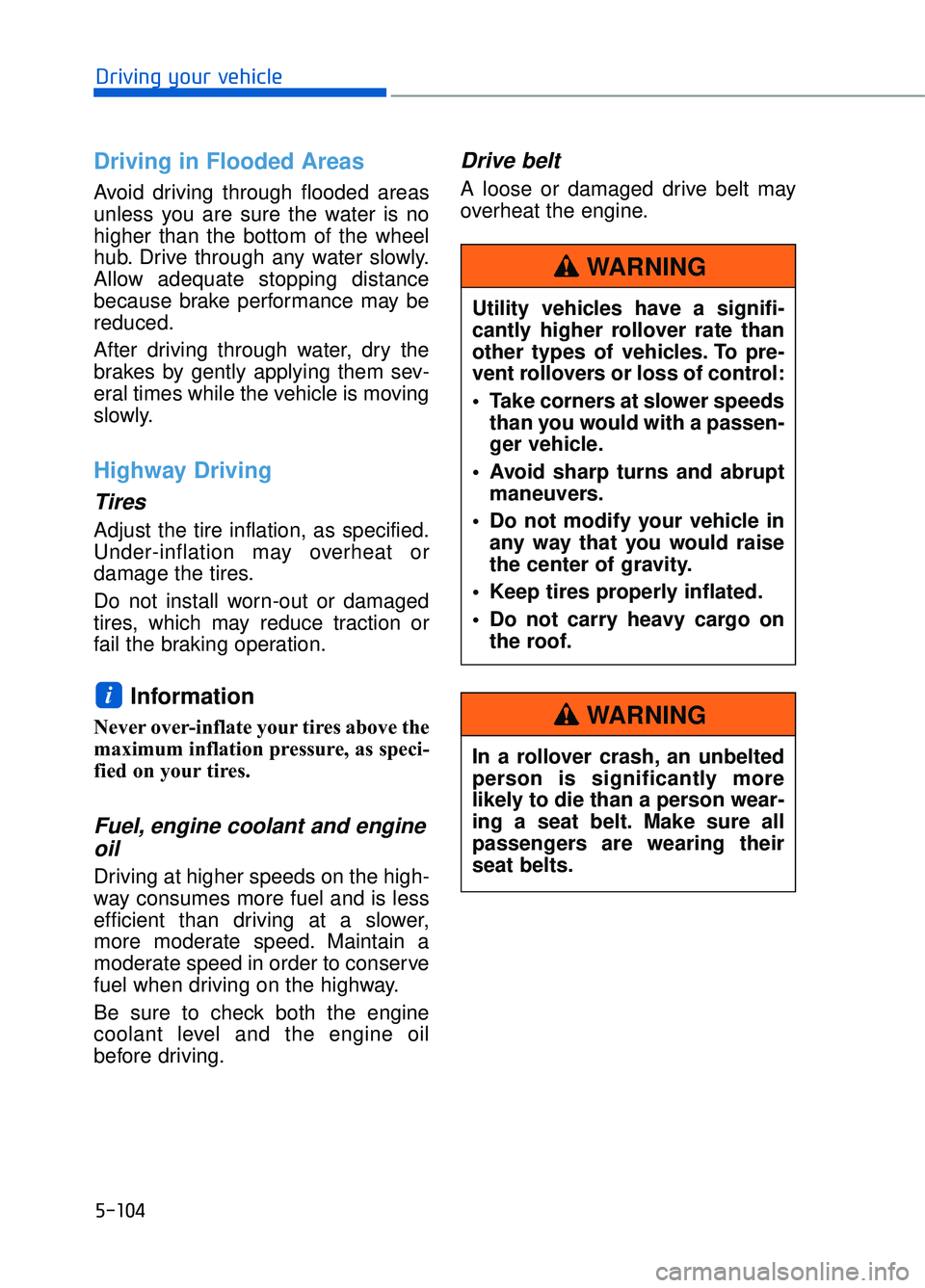
5-104
Driving your vehicle
Driving in Flooded Areas
Avoid driving through flooded areas
unless you are sure the water is no
higher than the bottom of the wheel
hub. Drive through any water slowly.
Allow adequate stopping distance
because brake performance may be
reduced.
After driving through water, dry the
brakes by gently applying them sev-
eral times while the vehicle is moving
slowly.
Highway Driving
Tires
Adjust the tire inflation, as specified.
Under-inflation may overheat or
damage the tires.
Do not install worn-out or damaged
tires, which may reduce traction or
fail the braking operation.
Information
Never over-inflate your tires above the
maximum inflation pressure, as speci-
fied on your tires.
Fuel, engine coolant and engineoil
Driving at higher speeds on the high-
way consumes more fuel and is less
efficient than driving at a slower,
more moderate speed. Maintain a
moderate speed in order to conserve
fuel when driving on the highway.
Be sure to check both the engine
coolant level and the engine oil
before driving.
Drive belt
A loose or damaged drive belt may
overheat the engine.
i
Utility vehicles have a signifi-
cantly higher rollover rate than
other types of vehicles. To pre-
vent rollovers or loss of control:
Take corners at slower speeds
than you would with a passen-
ger vehicle.
Avoid sharp turns and abrupt maneuvers.
Do not modify your vehicle in any way that you would raise
the center of gravity.
Keep tires properly inflated.
Do not carry heavy cargo on the roof.
WARNING
In a rollover crash, an unbelted
person is significantly more
likely to die than a person wear-
ing a seat belt. Make sure all
passengers are wearing their
seat belts.
WARNING
Page 376 of 524
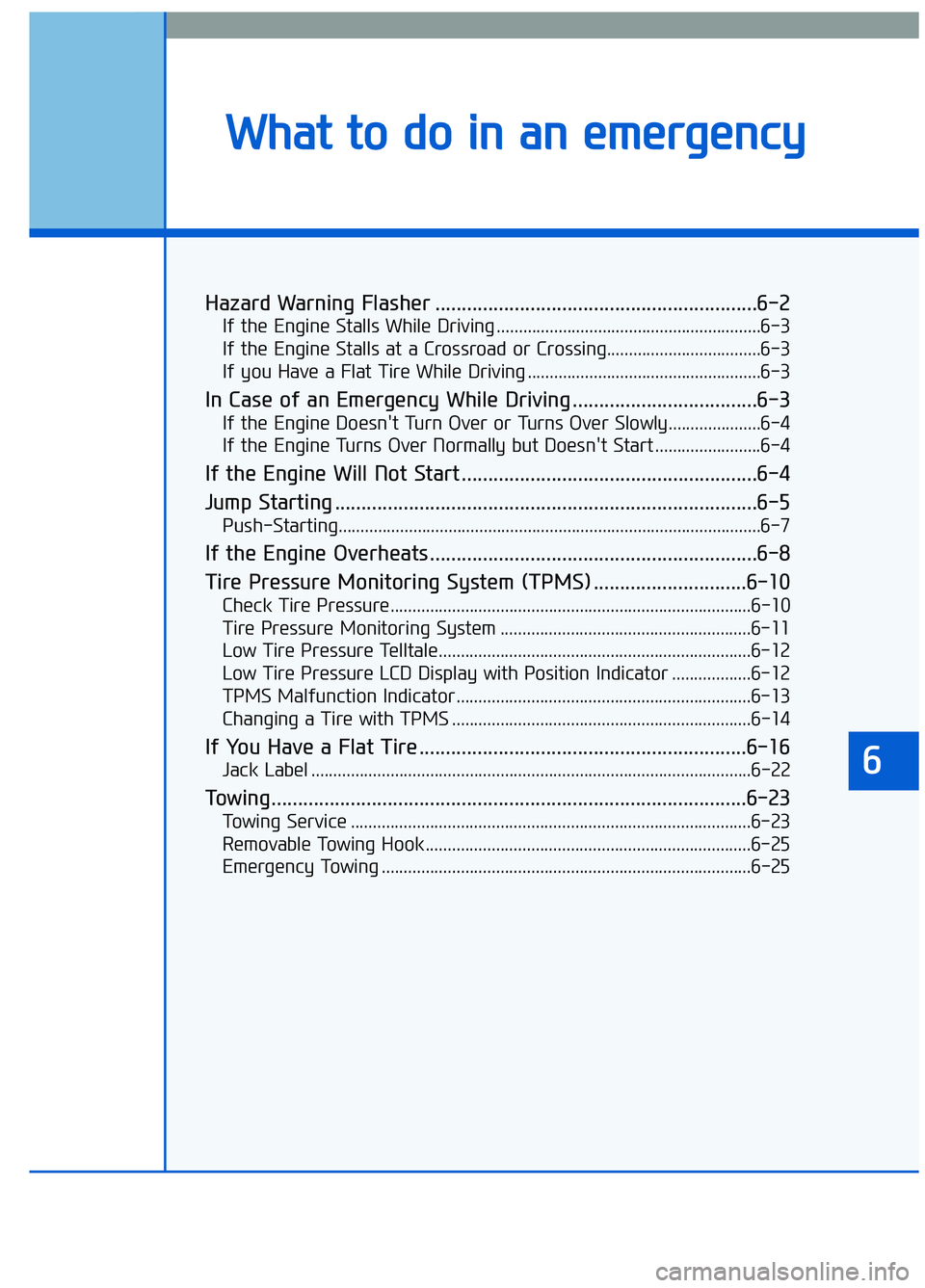
Hazard Warning Flasher .............................................................6-2
If the Engine Stalls While Driving ............................................................6-3
If the Engine Stalls at a Crossroad or Crossing...................................6-3
If you Have a Flat Tire While Driving .....................................................6-3
In Case of an Emergency While Driving ...................................6-3
If the Engine Doesn't Turn Over or Turns Over Slowly.....................6-4
If the Engine Turns Over Normally but Doesn't Start ........................6-4
If the Engine Will Not Start ........................................................6-4
Jump Starting ........................................................................\
........6-5
Push-Starting........................................................................\
........................6-7
If the Engine Overheats ..............................................................6-8
Tire Pressure Monitoring System (TPMS) .............................6-10
Check Tire Pressure........................................................................\
..........6-10
Tire Pressure Monitoring System .........................................................6-11
Low Tire Pressure Telltale.......................................................................6\
-12
Low Tire Pressure LCD Display with Position Indicator ..................6-12
TPMS Malfunction Indicator...................................................................6-13
Changing a Tire with TPMS ....................................................................6-14\
If You Have a Flat Tire ..............................................................6-16
Jack Label ........................................................................\
............................6-22
Towing........................................................................\
..................6-23
Towing Service ........................................................................\
...................6-23
Removable Towing Hook ........................................................................\
..6-25
Emergency Towing ........................................................................\
............6-25
6
W Wh
ha
at
t
t
t o
o
d
d o
o
i
in
n
a
a n
n
e
e m
m e
er
rg
g e
en
n c
cy
y
Page 383 of 524
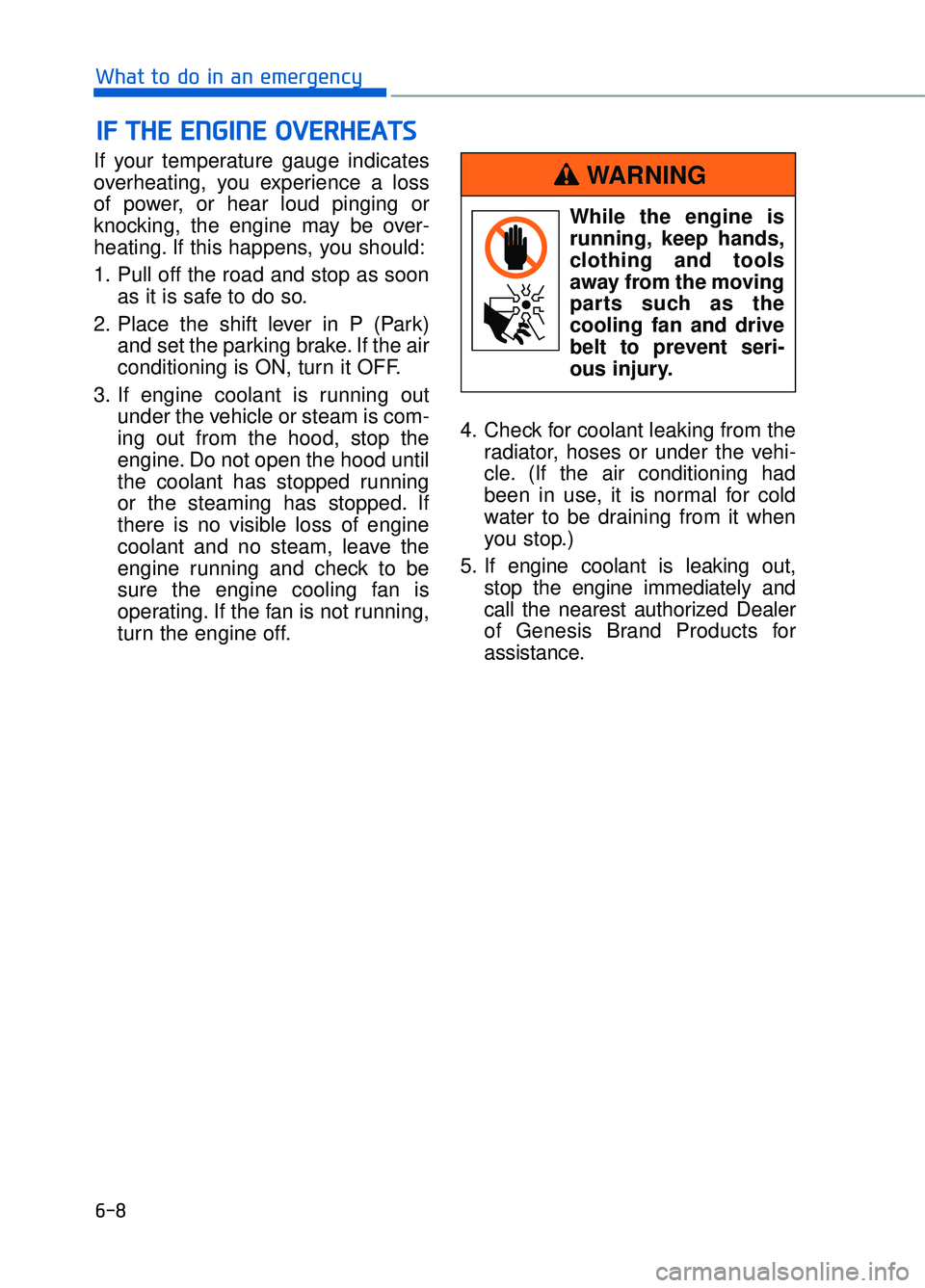
6-8
What to do in an emergency
If your temperature gauge indicates
overheating, you experience a loss
of power, or hear loud pinging or
knocking, the engine may be over-
heating. If this happens, you should:
1. Pull off the road and stop as soon as it is safe to do so.
2. Place the shift lever in P (Park) and set the parking brake. If the air
conditioning is ON, turn it OFF.
3. If engine coolant is running out under the vehicle or steam is com-
ing out from the hood, stop the
engine. Do not open the hood until
the coolant has stopped running
or the steaming has stopped. If
there is no visible loss of engine
coolant and no steam, leave the
engine running and check to be
sure the engine cooling fan is
operating. If the fan is not running,
turn the engine off. 4. Check for coolant leaking from the
radiator, hoses or under the vehi-
cle. (If the air conditioning had
been in use, it is normal for cold
water to be draining from it when
you stop.)
5. If engine coolant is leaking out, stop the engine immediately and
call the nearest authorized Dealer
of Genesis Brand Products for
assistance.
I IF
F
T
T H
H E
E
E
E N
N G
GI
IN
N E
E
O
O V
VE
ER
R H
H E
EA
A T
TS
S
While the engine is
running, keep hands,
clothing and tools
away from the moving
parts such as the
cooling fan and drive
belt to prevent seri-
ous injury.
WARNING
Page 384 of 524
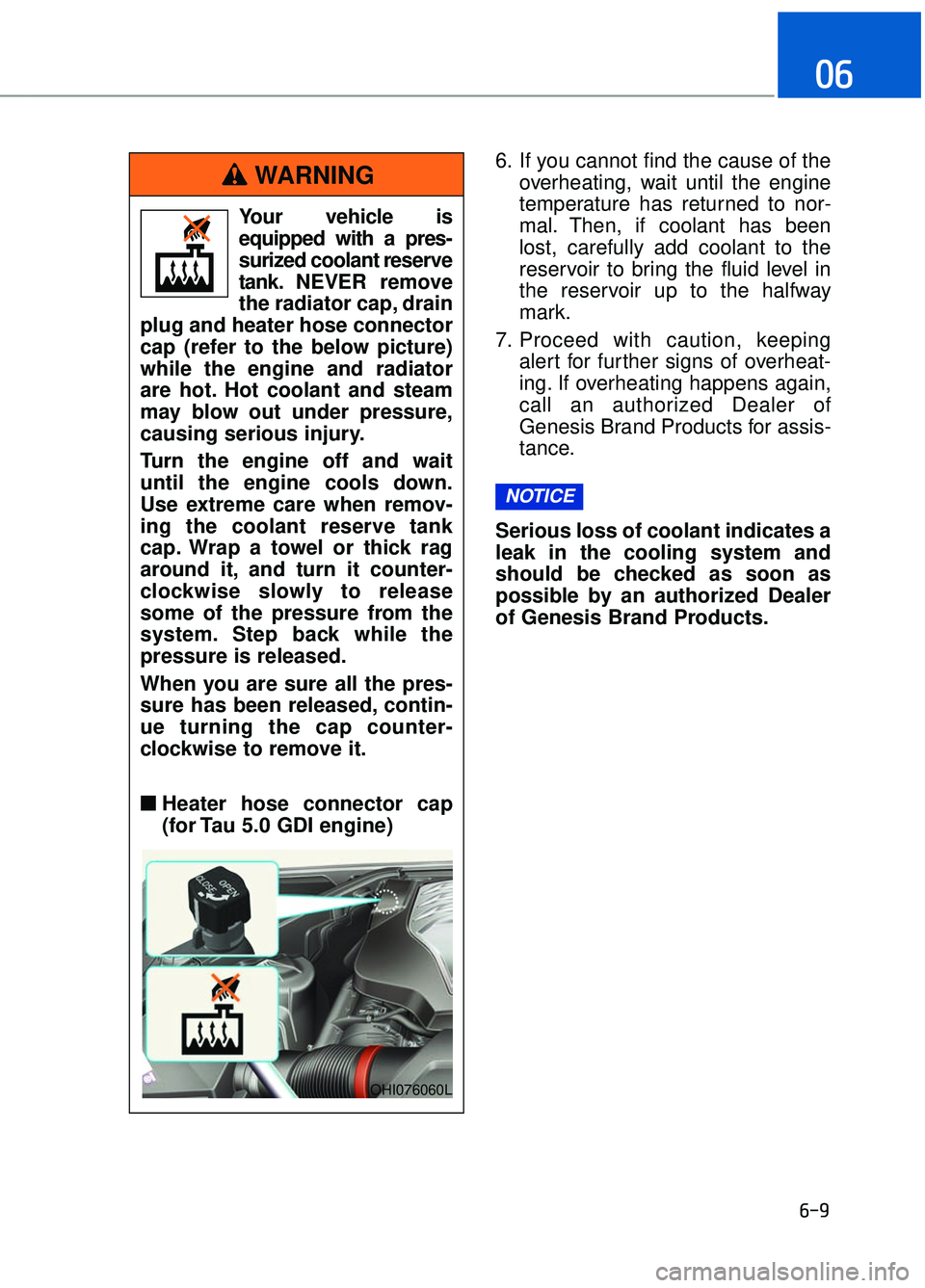
6-9
06
6. If you cannot find the cause of theoverheating, wait until the engine
temperature has returned to nor-
mal. Then, if coolant has been
lost, carefully add coolant to the
reservoir to bring the fluid level in
the reservoir up to the halfway
mark.
7. Proceed with caution, keeping alert for further signs of overheat-
ing. If overheating happens again,
call an authorized Dealer of
Genesis Brand Products for assis-
tance.
Serious loss of coolant indicates a
leak in the cooling system and
should be checked as soon as
possible by an authorized Dealer
of Genesis Brand Products.
NOTICE
Your vehicle is
equipped with a pres-
surized coolant reserve
tank. NEVER remove
the radiator cap, drain
plug and heater hose connector
cap (refer to the below picture)
while the engine and radiator
are hot. Hot coolant and steam
may blow out under pressure,
causing serious injury.
Turn the engine off and wait
until the engine cools down.
Use extreme care when remov-
ing the coolant reserve tank
cap. Wrap a towel or thick rag
around it, and turn it counter-
clockwise slowly to release
some of the pressure from the
system. Step back while the
pressure is released.
When you are sure all the pres-
sure has been released, contin-
ue turning the cap counter-
clockwise to remove it.
■ ■ Heater hose connector cap
(for Tau 5.0 GDI engine)
WARNING
OHI076060L
Page 513 of 524
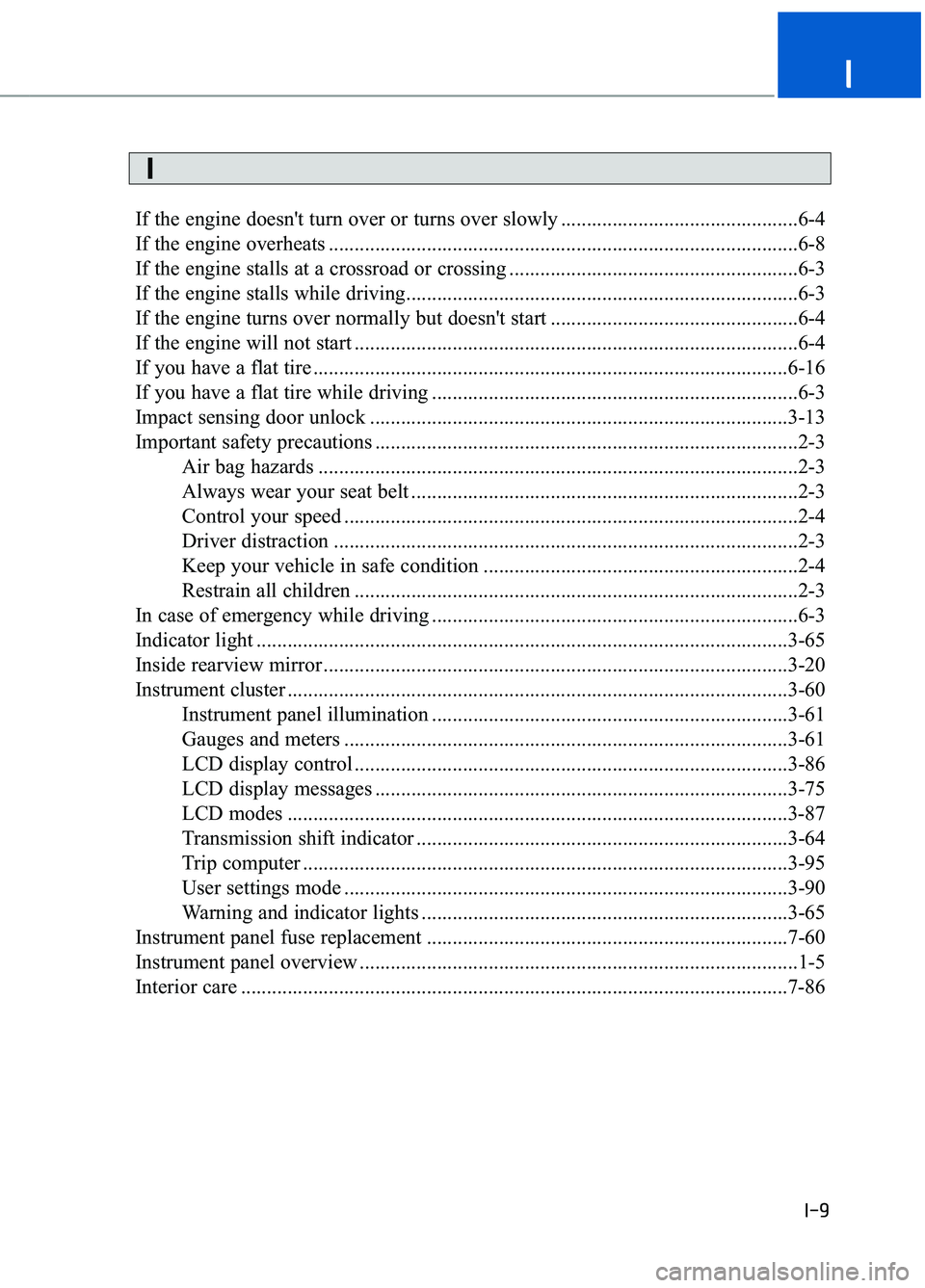
If the engine doesn't turn over or turns over slowly ..............................................6-4
If the engine overheats ........................................................................\
...................6-8
If the engine stalls at a crossroad or crossing ........................................................6-3
If the engine stalls while driving........................................................................\
....6-3
If the engine turns over normally but doesn't start ................................................6-4
If the engine will not start ........................................................................\
..............6-4
If you have a flat tire ........................................................................\
....................6-16
If you have a flat tire while driving .......................................................................6\
-3
Impact sensing door unlock ........................................................................\
.........3-13
Important safety precautions ........................................................................\
..........2-3Air bag hazards ........................................................................\
.....................2-3
Always wear your seat belt ........................................................................\
...2-3
Control your speed ........................................................................\
................2-4
Driver distraction ........................................................................\
..................2-3
Keep your vehicle in safe condition .............................................................2-4
Restrain all children ........................................................................\
..............2-3
In case of emergency while driving .......................................................................6\
-3
Indicator light ........................................................................\
...............................3-65
Inside rearview mirror ........................................................................\
..................3-20
Instrument cluster ........................................................................\
.........................3-60 Instrument panel illumination .....................................................................3-6\
1
Gauges and meters ........................................................................\
..............3-61
LCD display control ........................................................................\
............3-86
LCD display messages ........................................................................\
........3-75
LCD modes ........................................................................\
.........................3-87
Transmission shift indicator ........................................................................\
3-64
Trip computer ........................................................................\
......................3-95
User settings mode ........................................................................\
..............3-90
Warning and indicator lights .......................................................................3\
-65
Instrument panel fuse replacement ......................................................................7-\
60
Instrument panel overview ........................................................................\
.............1-5
Interior care ........................................................................\
..................................7-86
I-9
I
I